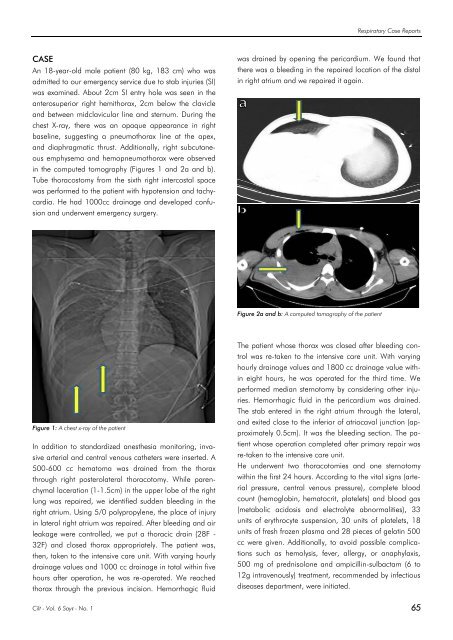Respircase Cilt: 6 - Sayı: 1 Yıl: 2017
Create successful ePaper yourself
Turn your PDF publications into a flip-book with our unique Google optimized e-Paper software.
Respiratory Case Reports<br />
CASE<br />
An 18-year-old male patient (80 kg, 183 cm) who was<br />
admitted to our emergency service due to stab injuries (SI)<br />
was examined. About 2cm SI entry hole was seen in the<br />
anterosuperior right hemithorax, 2cm below the clavicle<br />
and between midclavicular line and sternum. During the<br />
chest X-ray, there was an opaque appearance in right<br />
baseline, suggesting a pneumothorax line at the apex,<br />
and diaphragmatic thrust. Additionally, right subcutaneous<br />
emphysema and hemopneumothorax were observed<br />
in the computed tomography (Figures 1 and 2a and b).<br />
Tube thoracostomy from the sixth right intercostal space<br />
was performed to the patient with hypotension and tachycardia.<br />
He had 1000cc drainage and developed confusion<br />
and underwent emergency surgery.<br />
was drained by opening the pericardium. We found that<br />
there was a bleeding in the repaired location of the distal<br />
in right atrium and we repaired it again.<br />
Figure 2a and b: A computed tomography of the patient<br />
Figure 1: A chest x-ray of the patient<br />
In addition to standardized anesthesia monitoring, invasive<br />
arterial and central venous catheters were inserted. A<br />
500-600 cc hematoma was drained from the thorax<br />
through right posterolateral thoracotomy. While parenchymal<br />
laceration (1-1.5cm) in the upper lobe of the right<br />
lung was repaired, we identified sudden bleeding in the<br />
right atrium. Using 5/0 polypropylene, the place of injury<br />
in lateral right atrium was repaired. After bleeding and air<br />
leakage were controlled, we put a thoracic drain (28F -<br />
32F) and closed thorax appropriately. The patient was,<br />
then, taken to the intensive care unit. With varying hourly<br />
drainage values and 1000 cc drainage in total within five<br />
hours after operation, he was re-operated. We reached<br />
thorax through the previous incision. Hemorrhagic fluid<br />
The patient whose thorax was closed after bleeding control<br />
was re-taken to the intensive care unit. With varying<br />
hourly drainage values and 1800 cc drainage value within<br />
eight hours, he was operated for the third time. We<br />
performed median sternotomy by considering other injuries.<br />
Hemorrhagic fluid in the pericardium was drained.<br />
The stab entered in the right atrium through the lateral,<br />
and exited close to the inferior of atriocaval junction (approximately<br />
0.5cm). It was the bleeding section. The patient<br />
whose operation completed after primary repair was<br />
re-taken to the intensive care unit.<br />
He underwent two thoracotomies and one sternotomy<br />
within the first 24 hours. According to the vital signs (arterial<br />
pressure, central venous pressure), complete blood<br />
count (hemoglobin, hematocrit, platelets) and blood gas<br />
(metabolic acidosis and electrolyte abnormalities), 33<br />
units of erythrocyte suspension, 30 units of platelets, 18<br />
units of fresh frozen plasma and 28 pieces of gelatin 500<br />
cc were given. Additionally, to avoid possible complications<br />
such as hemolysis, fever, allergy, or anaphylaxis,<br />
500 mg of prednisolone and ampicillin-sulbactam (6 to<br />
12g intravenously) treatment, recommended by infectious<br />
diseases department, were initiated.<br />
<strong>Cilt</strong> - Vol. 6 <strong>Sayı</strong> - No. 1 65

















